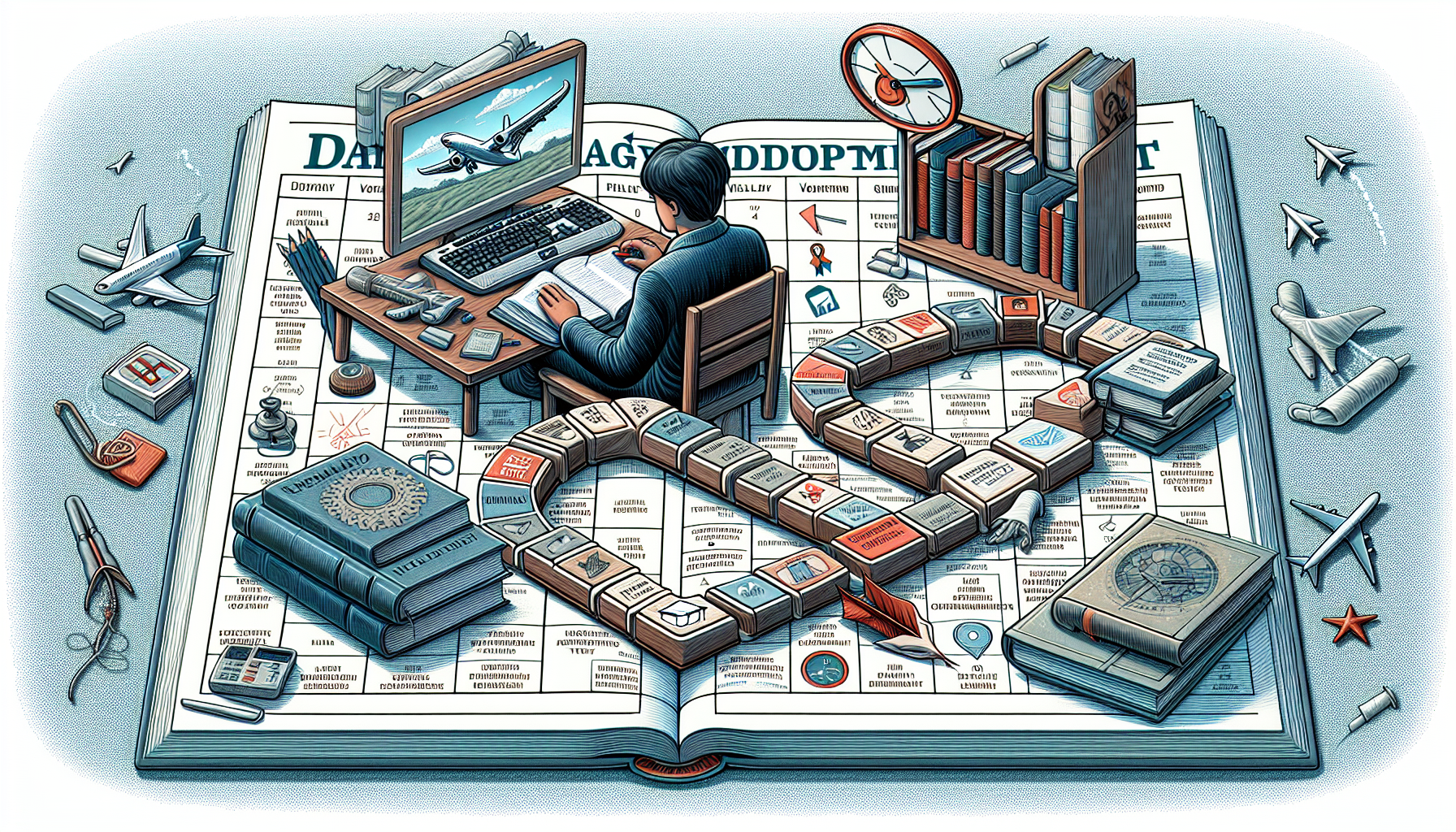Instrument Rating Guide: Requirements, Costs & Training
Dec 23, 2023
Have you ever imagined the freedom of flying through any weather conditions, or navigating with confidence and ease under Instrument Flight Rules (IFR)? If so, earning your instrument rating will unlock these possibilities and take your piloting skills to new heights. In this guide, we’ll walk you through the process of obtaining your instrument rating, examining the prerequisites, training, and exams necessary to achieve this valuable addition to your private pilot certificate.
Key Takeaways
-
Navigate complex airspace and adverse weather conditions with an Instrument Rating.
-
Requirements include aeronautical knowledge, flight proficiency, medical fitness certificate & English language proficiency.
-
Master navigation systems to prepare for the Knowledge Test and Checkride.
Navigating the Skies with an Instrument Rating

An instrument rating is an essential upgrade to your current private pilot certificate, empowering you to fly under Instrument Flight Rules (IFR) in any weather condition and at any altitude. This means you’ll be able to navigate through challenging weather conditions and complex airspace with increased safety and efficiency.
One of the most valuable ratings a pilot can obtain, an instrument rating not only prepares you for flying in low visibility and adverse weather conditions, but also grants you access to instrument procedures for significantly more efficient flight. Furthermore, obtaining an instrument rating enhances your aeronautical knowledge and proficiency in instrument flight maneuvers and procedures.
As an instrument-rated pilot, you’ll be able to:
-
Execute IFR flight plans, simplifying navigation through complex airspace
-
Fly in inclement weather
-
Expand your flying territory
-
Tackle challenging flight conditions
This mastery of instrument flight rules and procedures presents you with the confidence and competence to tackle challenging flight conditions.
Throughout your instrument flight training, you’ll develop expertise in IFR flight planning, clearances, and cross-country flight procedures. The final stage of your instrument course will focus on one cross country flight and navigation, exposing you to in-flight emergencies such as communication failure, avionics failure, and other emergency procedures.
Eligibility for Instrument Rating: Are You Qualified?
Before starting your pursuit of an instrument rating, ensure you satisfy the instrument rating requirements. To obtain an instrument rating, you must possess:
-
Aeronautical knowledge
-
Flight proficiency
-
A valid medical fitness certificate
-
English language proficiency
Beyond these general requirements, you must also accumulate specific flight hours and experiences. We’ll detail the needed aeronautical knowledge, flight proficiency targets, and medical and language prerequisites necessary for obtaining an instrument rating.
Aeronautical Knowledge Prerequisites
A strong foundation of aeronautical knowledge is essential for any aspiring instrument-rated pilot. This includes a comprehensive understanding of:
-
weather concepts and meteorology
-
navigation charts, systems, instruments, and procedures
-
weather patterns, cloud formations, atmospheric conditions, and weather hazards
-
the ability to interpret weather reports and forecasts
Familiarizing yourself with these concepts and skills will help you become a proficient instrument-rated pilot.
In addition to weather knowledge, you must be well-versed in FAA regulations and possess knowledge of navigation systems such as VOR, GPS, and ADF. To fully prepare for your instrument rating, consider studying resources such as The Pilot’s Manual: Instrument Flying, FAA Instrument Flying Handbook, and Instrument Procedures Handbook.
Flight Proficiency Milestones
To demonstrate your flight proficiency, you’ll need to meet specific flight hour milestones, including a minimum of 40 hours of actual or simulated instrument time. You’ll also need to have logged a total of 50 hours of cross-country flight time, 10 hours of which we're flown in real or simulated instrument conditions. You can accomplish these 10 hours by focusing on instrument procedures and becoming proficient in instrument flight maneuvers and procedures.
Instrument rating requirements also encompass a range of practical skills and experiences, such as:
-
Demonstrating the ability to fly a distance of at least 250 nm along airways or ATC-directed routing
-
Executing an instrument approach at each airport
-
Executing three different kinds of approaches with the use of navigation systems such as ILS, VOR, GPS, etc.
Achieving these milestones will ensure you have the necessary experience and skills to safely and confidently navigate under instrument flight rules.
Medical and Language Requirements
Medical fitness is a vital component of pilot eligibility, as it ensures you can manage the physical and cognitive demands of flying, particularly during challenging weather conditions. To obtain your instrument rating, you’ll need a valid medical certificate, which can be obtained via the Federal Aviation Administration’s website.
English language proficiency is also a requirement for obtaining an instrument rating, as it facilitates clear communication with air traffic control and other pilots. This means you’ll need to demonstrate the ability to speak, write, and understand the English language.
This ensures smooth communication and safe flight operations.
The Path to Instrument Rating Certification

Once you determine your eligibility for an instrument rating, you’ll commence a comprehensive training program combining ground and in-flight training. This program will cover theoretical knowledge, practical skills, and the specific requirements you’ll need to meet in order to obtain your certification.
We’ll detail the log ground training curriculum, in-flight training emphasis, and the process of meeting the requirements for obtaining an instrument rating.
Ground Training Syllabus
The ground training syllabus for instrument rating certification is designed to provide you with the theoretical knowledge and understanding of instrument flying. This includes learning about:
-
Regulations and procedures
-
Instrument navigation and communication systems
-
Instrument approach procedures
-
Weather analysis and interpretation
-
Aircraft systems and performance in instrument conditions
-
Human factors and crew resource management
-
Emergency procedures and equipment
To effectively prepare for your instrument rating, you’ll need to study a range of topics, such as:
-
Interpreting aircraft instruments
-
Instrument failures and their effects
-
Instrument departure procedures
-
Instrument enroute procedures
-
Instrument arrival and approach procedures
-
Flight training requirements
-
Instrument training requirements
A solid foundation in these areas will ensure that you’re well-equipped to succeed in your instrument rating journey.
In-Flight Training Focus
In-flight training for your instrument rating will focus on the practical application of instrument flying techniques and procedures. You’ll receive flight instruction on the required areas of operation and gain experience in actual or simulated instrument flight conditions.
This hands-on training, led by an authorized instructor, is essential for developing the skills and knowledge necessary to safely and confidently navigate under instrument flight rules. The in-flight training component of your instrument rating course will provide you with valuable experience in handling various flight conditions and situations, preparing you for the demands of real-world instrument flight.
Checking Off the Requirements
As you advance in your instrument rating training, you’ll have to pass examinations and show flight proficiency to earn your certification. The Checkride, a critical component of the instrument rating process, consists of both a theoretical (oral) and practical (flight) examination.
During the practical exam, you’ll need to demonstrate your ability to execute successful instrument flight maneuvers, instrument navigation, and instrument approaches under partial panel conditions. Thorough preparation, practice, and a strong understanding of the required material will ensure your success in both the written and practical exams.
Cost Analysis of Instrument Rating Training
Earning your instrument rating is a significant investment in your future as a pilot. The expenses involved in obtaining this valuable certification can vary depending on factors such as tuition, materials, and flight hours. To help you navigate the financial aspect of your instrument rating journey, consider exploring financing options and funding programs that may be available to you.
Keep in mind that investing in your instrument rating is not only an investment in your skills and capabilities as a pilot but also an investment in your safety and future career opportunities. A carefully planned budget for your instrument rating training can alleviate financial strain, allowing you to concentrate on becoming a proficient pilot.
Timeline to Instrument Rating Completion

The timeline to complete your instrument rating will vary depending on factors such as your availability, dedication, and the pace at which you progress through the course. Full-time students typically complete the course within 2-3 months. However, your individual completion timeline may be influenced by factors such as the amount of flying time dedicated to training, weather conditions, mechanical issues, and your personal schedule and availability for training sessions.
Maintaining dedication to your instrument rating pursuit and allocating consistent time to both ground and in-flight training will put you on the path to mastering the necessary skills for navigating under instrument flight rules.
Advanced Instruments and Techniques
Mastering advanced instruments and techniques is an integral part of your instrument rating journey. As you progress through your training, you’ll develop expertise in navigation systems, approach and emergency operations, and simulated scenarios. These advanced skills will not only facilitate a smooth transition to instrument flight instruction but also enhance your overall proficiency and confidence as a pilot.
You'll examine the mastery of navigation systems, approach and emergency operations, and simulated scenarios you’ll need to develop during your instrument rating training.
Mastery of Navigation Systems
Navigating under instrument flight rules requires a thorough understanding of advanced navigation systems such as VOR, GPS, and ADF. Through training and practice, you’ll become familiar with the features and functions of each system and learn how to interpret the data provided by these systems, ensuring a smooth transition to visual flight rules when necessary.
Practicing the use of these navigation systems during simulated and actual flights will not only help you hone your skills but also ensure that you’re well-prepared to navigate complex airspace and challenging flight conditions with confidence.
Approach and Emergency Operations
Approach and emergency operations are critical components of instrument flight, requiring proficiency in instrument approach procedures, holding patterns, and emergency procedures. Developing expertise in these areas is essential for ensuring safe and precise navigation during the approach and landing phase of your flight, taking into account terrain, obstacles, and weather conditions.
In addition to mastering the standard instrument approach procedures, it’s essential to be prepared for emergency situations that may arise during instrument flight, such as in-flight fires, instrument failures, or generator failures. By familiarizing yourself with the appropriate emergency procedures, you’ll be equipped to handle any critical circumstances that may arise during your instrument flight journey.
Simulated Scenarios
Simulated scenarios offer a safe and controlled environment in which you can practice and experience various flight situations, from navigating through complex airspace to performing instrument approaches and landings. By providing realistic training scenarios that replicate the aircraft environment, flight simulators, flight training devices, and virtual reality technologies enhance your pilot skills and situational awareness.
These simulated scenarios not only allow you to gain experience and confidence before encountering similar situations in actual flight but also provide valuable opportunities for improving:
-
Situational awareness
-
Decision-making
-
Emergency procedures
-
Instrument flying techniques.
Preparing for the Knowledge Test and Checkride
As you near the end of your instrument rating pursuit, ensure you are well-prepared for both the knowledge test and checkride. Here are some study techniques and resources that can help you:
-
Use question banks and practice tests to test your knowledge and identify areas that need improvement.
-
Use comprehensive study guides to review all the necessary information.
-
Consider enrolling in a formal ground school course to receive structured instruction and guidance. By utilizing these study techniques and resources, you can build a strong foundation of knowledge and increase your chances of success in the theoretical (oral) examination.
During the practical (flight) examination, you’ll need to demonstrate your proficiency in executing successful instrument flight maneuvers, instrument navigation, and instrument approaches under partial panel conditions. By thoroughly preparing for both the written and practical exams, you’ll increase your chances of success and move one step closer to earning your instrument rating.
After the Rating: Continuing Your Pilot Journey
With your private pilot license and instrument rating secured, you’re now prepared to progress in your piloting endeavors. Obtaining a Commercial Pilot License is the subsequent milestone required to pursue a professional pilot career. This certification permits you to transport passengers for remuneration and opens up a range of exciting career opportunities, such as airline pilot, regional airline pilot, flight instructor, and many more.
By continuing to build upon the skills and knowledge you’ve gained through your instrument rating training, you’ll be well-positioned to excel in your chosen aviation career and soar to new heights in the world of flight.
Summary
In conclusion, obtaining an instrument rating is a challenging yet rewarding journey that can greatly enhance your piloting skills and career prospects. Through dedicated study, practice, and mastery of advanced instruments and techniques, you’ll gain the confidence and proficiency required to navigate under instrument flight rules and tackle a variety of flight conditions.
So, as you embark on this exciting adventure, remember that the sky is truly the limit. With determination, perseverance, and a passion for flight, your instrument rating journey will undoubtedly lead to a lifetime of rewarding experiences and achievements as a skilled and proficient pilot.
Frequently Asked Questions
What does an instrument rating do?
An Instrument Rating enables pilots to operate under an IFR flight plan, allowing them to traverse areas with varying weather conditions and limited ground-based navigation aids. It also allows pilots to add instrument qualifications to their certificate for either single or multi engine aircraft, with the qualification earned being known as an SEIR or MEIR respectively. It is a challenging and rewarding rating that can be very valuable to pilots.
How hard is it to get instrument rated?
Getting instrument rated is difficult, as you must pass a 60-question test with 70% or higher accuracy to be successful. You must also show the FAA examiner you are proficient in the complex world of instrument operations. But with diligent study and practice, this admirable goal is absolutely within reach!
What are instrument type ratings?
An Instrument Rating (IR) is an important pilot rating focused on flying solely by reference to instruments. It requires intensive training, but is a rewarding and challenging discipline of flight training.
How much should an instrument rating cost?
Expect an instrument rating to cost between $7,000 and $9,000, as set out by the FAA. Most students require more training than the minimum requirements, so costs may be slightly higher.
What is the minimum flight time required for an instrument rating?
For an instrument rating, you must have a minimum of 40 hours of actual or simulated instrument time.
